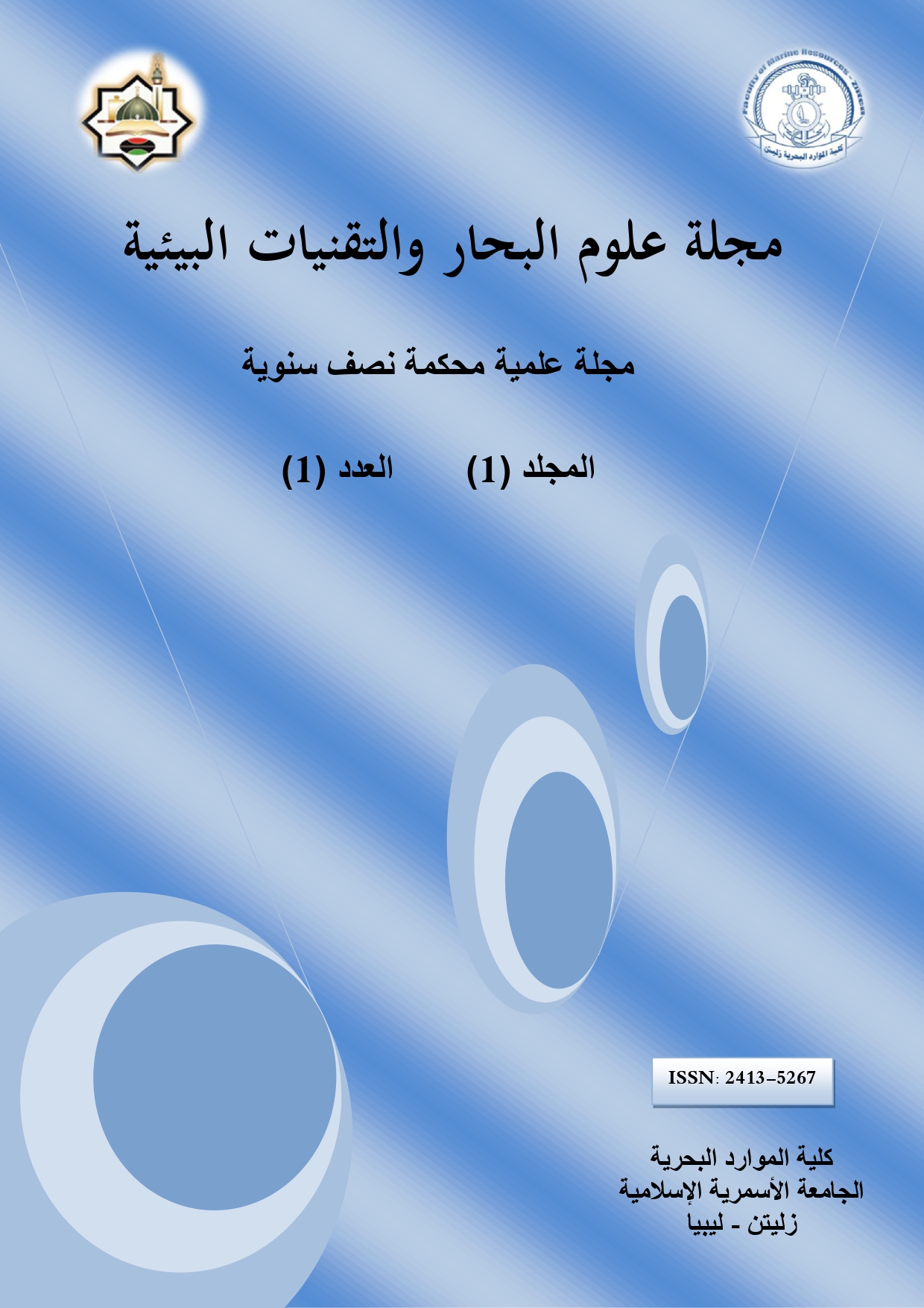إزالة الزرنيخ والفلور والرصاص من المياه الملوثة باستخدام عديد مثخن غير عضوي جديد
DOI:
https://doi.org/10.59743/jmset.v1i1.135الكلمات المفتاحية:
رماد قش الأرز، السيليكا المنشطة، سيليكات الصوديوم، عديد المثخن الغير عضوي، إزالة الملوثاتالملخص
تسلط الدراسة الضوء على إزالة بعض الملوثات الخطيرة مثل الزرنيخ ، والفلور والرصاص من المياه الملوثة باستخدام عديد المثخن الغير عضوي الجديد، عدد ثمانية من عديد مثخن غير عضوي جديد تم تحضيرها وتوصيفها وهى عديد كلوريد الألمونيوم، عديد كلوريد الألمونيوم والسيلكون، عديد كبريتات الألمونيوم الهيدروكسيلية، عديد كبريتات الألمونيوم الهيدروكسيلية والسيلكون، عديد كلوريد الحديد، عديد كلوريد الحديد والسيلكون، عديد كلوريد الألمونيوم والحديد، عديد كلوريد الالمونيوم والحديد والسيلكون، التطبيقات تم إجراءها على إزالة الملوثات من المياه الملوثة ووجد أن أقصى إزالة للرصاص، الزرنيخ و الفلورمن المياه الملوثة سُجلت 99.98 و 97 و 99 % من المياه الملوثة على التوالي باستخدام عديد المثخن الغير عضوي لكبريتات الألمونيوم الهيدروكسيلية والسيلكون، وكلوريد الألمونيوم والحديد والسليكون وكلوريد الألمونيوم والحديد والسليكون على التوالي. وبناءً على هذه النتائج فإن عديد المثخن الغير عضوي المطعم بالسليكا يعتبر من المثخنات الجيدة في معالجه المياه الملوثة لتكلفته الصغيرة، وكفاءته العالية في هذا التطبيق بالإضافة إلى إسهامه في حل مشكله نقص المياه من خلال استدامته في المحافظة على مصادر المياه الغير تقليديه.
التنزيلات
المراجع
Aboabboud M., Ibrahim H.G., Okasha A., and Elatrash M. S. (2013). Investigation of Chromium Removal by Adsorption/Precipitation Techniques using Solid Waste Material. In: Digital Proceeding of the (ICOEST’2013), 18-21 June, Cappadocia, Nevsehir, Turkey. Journal of Selcuk University Natural and Applied Science, Special Issue: 538-545.
Abo-El-Enein S.A., Eissa M.A., Diafullah A.A., Rizk M.A., & Mohamed F.M. (2009). Removal of some heavy metals ions from wastewater by copolymer of iron and aluminum impregnated with active silica derived from rice husk ash. Journal of Hazardous Materials, 172(2): 574-579.
Abo-El-Enein S.A., Eissa M.A., Diafullah A.A., Rizk M.A., & Mohamed F.M. (2011). Utilization of a low cost agro-residue for production of coagulant aids and their applications. Journal of Hazardous Materials, 186(2): 1200-1205.
Ahmed F.M.M. (2009). Treatment of some water pollutants using novel sorbent materials. PhD Thesis, Ain Shams University, Egypt.
Al-Meshragi M.A., Ibrahim H.G, and Okasha A.Y. (2009). Removal of trivalent chromium from aquatic environment by cement kiln dust: Batch studies. In: IAENG Transactions engineering Technologies Vol. (2), 1127(1):74-85. American Institute of Physics, Conference Proceedings.
Bellack E. (1971). Arsenic removal from potable water. Journal of the American Water Works Association, 63(7): 454-458.
Bin Jusoh A., Cheng W.H., Low W.M., Nora’aini A., & Noor M.M.M. (2005). Study on the removal of iron and manganese in groundwater by granular activated carbon. Desalination,
(1): 347-353.
Della V.P., Kühn I., & Hotza D. (2002). Rice husk ash as an alternate source for active silica production. Materials Letters, 57(4): 818-821.
DeMarco M.J., SenGupta A.K., & Greenleaf J.E. (2003). Arsenic removal using a polymeric/inorganic hybrid sorbent. Water Research, 37(1): 164-176.
Federation W.E. (FEW), & American Public Health Association (APHA) (2005). Standard methods for the examination of water and wastewater. 19th ed., American Public Health Association (APHA): Washington DC.
Foletto E.L., Gratieri E., Oliveira L.H.D., & Jahn, S.L. (2006). Conversion of rice hull ash into soluble sodium silicate. Materials Research, 9(3): 335-338.
Gupta A.S. (2002). Environmental separation of heavy metals. Lewis Publishers, New York.
Jekel M.R. (1994). Removal of arsenic in drinking water treatment. John Wiley and Sons LTD, New York, 6: 119–130.
Kalapathy U., Proctor A., & Shultz J. (2000). A simple method for production of pure silica from rice hull ash. Bioresource Technology, 73(3): 257-262.
Kartinen E.O. & Martin C.J. (1995). An overview of arsenic removal processes. Desalination, 103(1): 79-88.
Kaur S., Walia T.P.S., & Mahajan R.K. (2008). Comparative studies of zinc, cadmium, lead and copper on economically viable adsorbents. Journal of Environmental Engineering and Science, 7(1): 83-90.
Kim M.J. & Nriagu J. (2000). Oxidation of arsenite in groundwater using ozone and oxygen. Science of the Total Environment, 247(1): 71-79.
Krishnarao R.V., Mahajan Y.R., & Kumar T.J. (1998). Conversion of raw rice husks to SiC by pyrolysis in nitrogen atmosphere. Journal of the European Ceramic Society, 18(2): 147-152.
Krishnarao R.V., Subrahmanyam J., & Kumar T.J. (2001). Studies on the formation of black particles in rice husk silica ash. Journal of the European Ceramic Society, 21(1): 99-104.
Molnár L.U., Virčíkova E., & Lech P. (1994). Experimental study of As(III) oxidation by hydrogen peroxide. Hydrometallurgy, 35(1): 1-9.
Munter R., Ojaste H., & Sutt J. (2005). Complexed iron removal from groundwater. Journal of Environmental Engineering, 131(7): 1014-1020.
Namasivayam C., & Ranganathan K. (1995). Removal of Cd(II) from wastewater by adsorption on “waste” Fe(III) Cr (III) hydroxide. Water Research, 29(7): 1737-1744.
Okasha A.Y. & Ibrahim H.G. (2010). Removal of Cu2+ Ions from Aqueous Solutions by Adsorption on a Libyan Soil. J. of Environmental Science and Engineering, 4(10):9-15.
Okasha A.Y., Ibrahim H.G., Elatrash M.S., and Marie A.A. (2012). Removal of Cadmium from Aqueous Solutions Using Adsorption Technique: Kinetics and Equilibrium. International Journal of Environment and Bioenergy, 1(2): 105-118.
Patterson J.W. (1985). Industrial wastewater treatment technology. Science Publishers, New York.
Reddad Z., Gerente C., Andres Y., & Le Cloirec P. (2002). Adsorption of several metal ions onto a low-cost biosorbent: kinetic and equilibrium studies. Environmental science & technology, 36(9): 2067-2073.
Riveros H., & Garza C. (1986). Rice husks as a source of high purity silica. Journal of Crystal Growth, 75(1): 126-131.
Viraraghavan T., Subramanian K.S., & Aruldoss J.A. (1999). Arsenic in drinking water—problems and solutions. Water Science and Technology, 40(2): 69-76.
Wasay S.A., Tokunaga S., & Park S.W. (1996). Removal of Hazardous Anions from Aqueous Solutions by La (III)-and Y (III)-lmpregnated Alumina. Separation science and technology, 31(10): 1501-1514.
Yalcin N. & Sevinc V. (2001). Studies on silica obtained from rice husk. Ceramics International, 27(2): 219-224.
Yuan Y.L., Wen Y.Z., Li X.Y., & Luo S.Z. (2006). Treatment of wastewater from dye manufacturing industry by coagulation. Journal of Zhejiang University Science A, 7(2): 340-344.
التنزيلات
منشور
إصدار
القسم
الرخصة
الحقوق الفكرية (c) 2015 مجلة علوم البحار والتقنيات البيئية

هذا العمل مرخص بموجب Creative Commons Attribution 4.0 International License.












